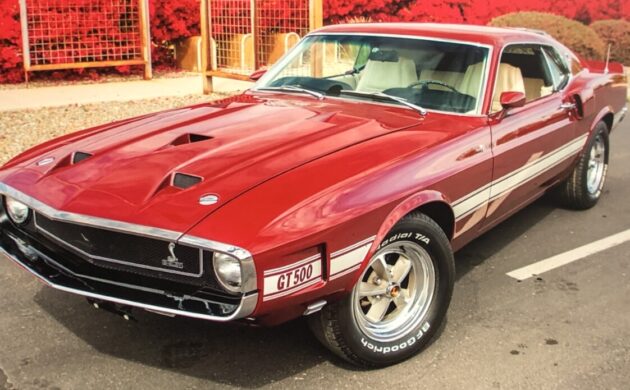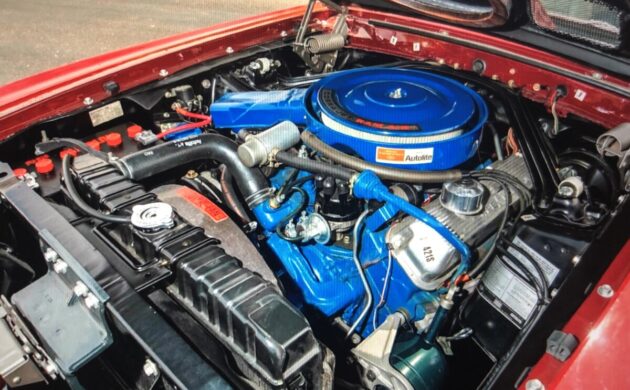Larry D spied this superb 1969 Shelby GT500, which will be going up for auction in Dallas at the Mecum event in early September. The story is familiar—the 1969 and 1970 Shelby cars were the last of the first-generation of Shelby automobiles, built on the third iteration of the Mustang, and the end of the line for Carroll Shelby’s direct involvement. But they still make for mighty cruisers. In addition, this Shelby is called out for having originally been delivered in the Canadian market. We’ll find out its fate when someone puts up the bidder paddle in Dallas and then watches it roll out to the parking area, after which the lucky buyer will arrange transport to its new home.
By the late 1960s, a Shelby Mustang was no longer created in a skunkworks with Shelby himself presiding over the conversion. Instead, Ford built them in Southfield, MI. The ’69s were decidedly not as popular as their predecessors, signalled by the fact that Ford had to re-VIN between 600-800 (depending on what you’re reading) leftover 1969s as 1970s, along with adding chin spoilers and hood stripes in black to give them at least some model year distinction. The car here, being a 1969, didn’t undergo that further upgrade treatment It does, however, have the distinction of having been originally delivered to Canada, though I’m mildly curious as to why the auction company makes a big deal of the fact. It sold originally in Saskatoon, Saskatchewan, at Dominion Motors. Apparently, it is one of only 83 cars imported (or exported, depending on which side of the 49th parallel you stand on) into the Northern Neighbor. As a Canadian, I find this mostly irrelevant. If this were today, the car would have to register its MPH and odo in kilometers, but that didn’t start until after this Shelby was produced. If it were being exported to Europe, it would have to have lights and turn signals that correspond to Euro rules. But as far as I can find, there’s nothing that would have made this Shelby any different than a US-market car. Barnfinders, what do you say about that? Does it give a bump in value? Are there differences in the Canadian-market cars?
Even if that’s not a compelling reason to buy this car, there are lots of reasons to want it. The perfect execution of its color scheme, Royal Maroon over white with a white side stripe. The rear end with the dual center (“centre” if you’re Canadian) exhausts and the distinctive taillights and Shelby badging. The spit-shined engine, which just happens to be a 428 Cobra Jet Ram Air. You also get documentation in the form of the original build sheet, a copy of the order sheet, and the Marti Report. It would have been nice to have seen some of those mixed in with the pro-quality photos the auction house supplied of the car. I’d also like to know how many miles are on the car and what mechanical history it has. Engine rebuild? Suspension work?
Of course, it’s impossible to talk about value since this car doesn’t have a number on it. Two people in the room in Dallas could drive it to insane levels. At the moment, similar cars are advertised for anywhere from $50K to $150K. If you’re wondering about the quality, the pictures more or less tell the tale, though it’s not detailed what “comprehensive restoration” stands for. It’s cold and wintry on the Prairies. Was this one decimated by salt? How long did that go on? Some of your questions might be answered by a look at the Shelby Registry, where this car is documented. But still, some photos underneath and in the trunk would clear up some questions, or you’ll just have to get to Dallas, put on your coveralls, and have a crawl around underneath. Then when you win the auction, the tough choice will be whether to drive this GT500 or show it.





Beauty, eh?
‘ll have the Jelly, eh!
The reason Canadian market cars command more interest and often a bit more money..is because the paper trail is much more detailed and easier to uncover with Canadian cars.This is due to the extreme detail the importing and whatnot stuffs the government did.As an example,one of the hardest cars to research the authenticity of is the 1962 bubbletop Bel Air 409 2×4 in the U.S. because there wasnt proper codes breakdown and they are easily cloned.Unless..it’s a Canadian one..every single code is available and impossible to clone.In the end,it’s all about detailed paperwork you get with Canadian cars.
Thanks for this excellent clarification. Great example of the Bubbletop too.
Brian (writer of the post)
Looks great and ready for another “Mecum Moment”
These weren’t the all out race cars that the earlier ones were, but certainly the most beautiful Mustangs of their generation.
the colors of this one just grab me; probably the nicest combination out there!
It’s probably wrong to want to have sex with a car, but…